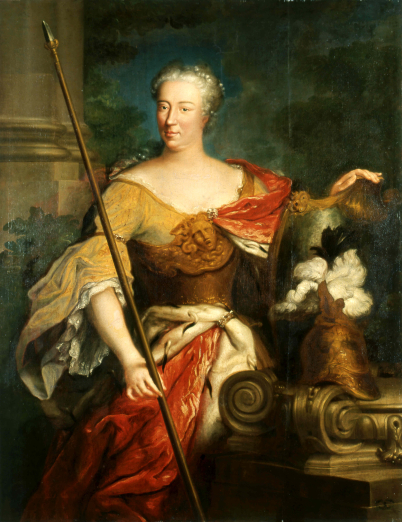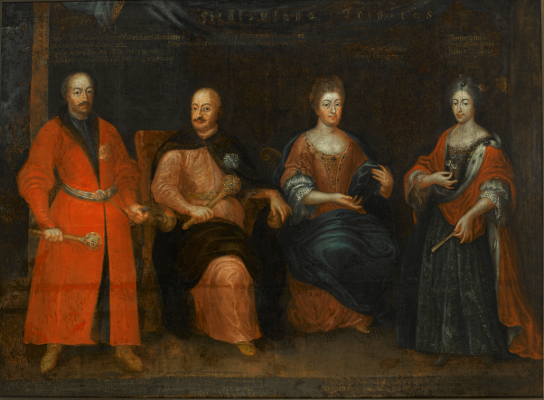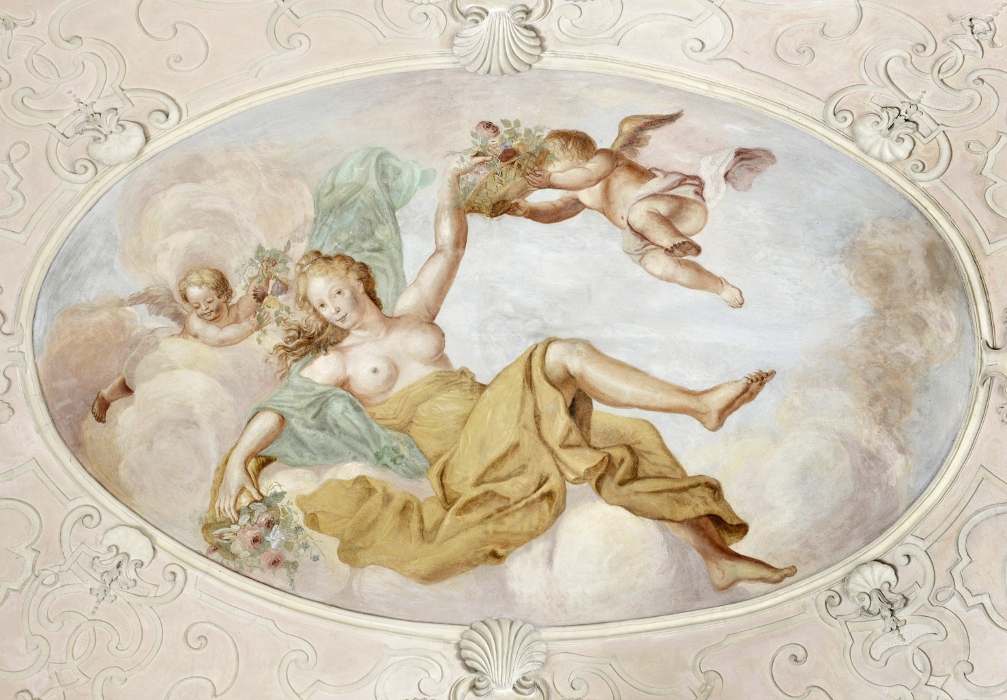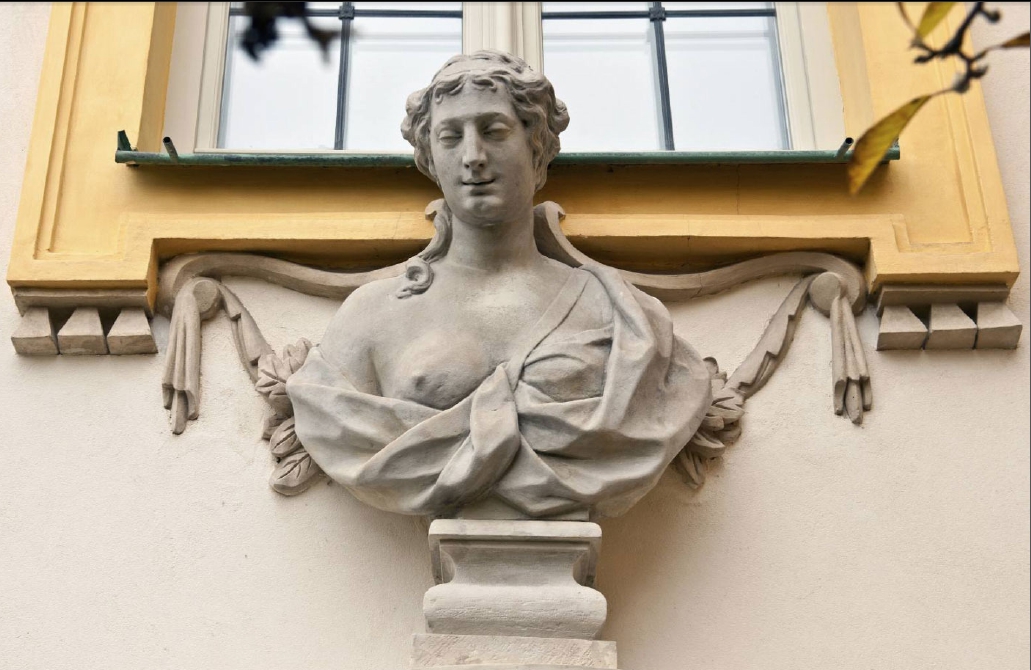
Elżbieta Helena Sieniawska née Lubomirska (ca. 1669–1729) was the only daughter of Zofia née Opalińska (d. 1675) and Stanisław Herakliusz Lubomirski (d. 1702). Her talented parents bequeathed to her an interest in culture, while her own diligence and persistence elevated her to a high rank in local and international politics. Orphaned by her mother at an early age (the Marshal’s daughter was only five at the time of her death), she was raised at the court of her father in Wiśnicz and that of her uncle, Hieronim Augystyn Lubomirski, in Rzeszów. These were two of the most significant stages of political battles in the country, as well as bustling cultural and social hubs. The young Elżbieta Lubomirska received basic education in Visitation Sisters’ Pension for Ladies in Warsaw, where she spent three years (1677–80) learning French and old Polish etiquette. Her education continued at the court of Queen Marie Casimire Sobieska; due to her birth, she immediately joined the Queen’s upper frauzimmer. The formation of young Elżbieta’s psychological outlook culminated at the court. It is likely that the Queen had to some extent acted as a surrogate mother to the young girl, becoming her trusted friend, but most of all a mentor in the world of courtly intrigues and politico-social nuances. By educating the young Lubomirska, the Queen gained a devoted supporter and a loyal ally in the Lubomirski family, a clan whose support for the King tended to waver.
Lubomirska’s marriage to the Voivode of Belz, Adam Mikołaj Sieniawski (d. 1726), concluded in July 1687, significantly helped Elżbieta achieve independence — from that point on, she engaged in an intense struggle to raise her family’s position. Though she has opposed her own family by siding with the Sobieskis during the interregnum, her gestures and actions from that point on focused unambiguously on improving the prestige of her own house. A series of promotions received by Sieniawski (largely thanks to Elżbieta’s efforts) advanced the couple’s status — within a decade, Adam Mikołaj took up the highest positions, becoming Field Hetman of the Crown in 1702 and Grand Hetman of the Crown four years later. This string of successes was crowned with a nomination as Castellan of Cracow in 1710. From that point on Elżbieta, the influential ‘First Lady of Cracow’, enjoyed a broader political, economic, and cultural influence.

Foreign politicians saw Sieniawska as a strong ally and supporter of the French party: she had played an important part in the manoeuvres and plans of the French diplomats, both during the interregnum — when Prince François de Conti was promoted as a contender for the crown — and later, when she became involved in a relief effort for Hungarian rebels. On that occasion, she aided the leader of the uprising, Prince Ferenc Rákóczi, and the rebels by enlisting the support of Adam Mikołaj Sieniawski for their cause, furnishing them with weapons, and hosting them in the safety of Sieniawski’s estates at Skole and Berezhany. On the national stage, Sieniawska maintained positive relations with the party of King August II, but did not shirk from engaging in talks with the Swedish or Russian camp, if current events demanded such actions and tangible political gains were at stake. Yet, she never did side with the Swedes or give in to illusive promises — for instance, that the crown might be hers to take — ‘for fear of becoming the butt of Tsar’s joke’. In this manner, she gradually rose to the rank of the most important minor player in Commonwealth politics, acting as an intermediary in affairs and quarrels involving her husband while amassing a coterie of supporters and devoted cooperators who owed their employment and careers to her — whether in administration, politics, or the military. Her contemporaries saw her as a generous patron, but also a tenacious and gravely threatening opponent when her trust was betrayed.
The Lady Castellan’s complex personality and the breakneck pace of her life are revealed in the correspondence between Sieniawska and people within her sphere of influence. Several thousand letters addressed to family, friends, administrators, and subjects, paint an image of diligence and truly incredible dedication to keeping the properties in operation and surrounding the workers not only with control, but also care. Sieniawska wrote nearly every day and at almost any hour of day or even night — a fact she indicated by precisely dating the letters. The only obstacle to her writing was her health — primarily problems with sight, rheumatism of the hands, or migraines; only when suffering bouts of these ailments did she enlist the aid of a secretary, while still personally signing every letter. The regular exchanges of letters serve to portray the intellect and mentality of Sieniawska and her contemporaries. The Lady Castellan comes across as a powerful figure, consistent in her actions and efforts to organise the space she inhabited. She was capable of identifying and exploiting opportunities for improving the situation of her own family and collaborators. With meticulous care, she attended to even the most minor of details.
The flow of both correspondence and information — that is, the maintenance of complex communication within Lady Castellan’s milieu — was the responsibility of newsagents and specialised postmasters in major centres of the country. Thus, she engaged in a regular cooperation with postmasters of Cracow, Lviv, Warsaw, Toruń, Gdańsk, etc., who informed her about current political as well as economical trends. Trading with Gdańsk merchants allowed Sieniawska to keep track of the prices of the most important products, especially grain and calamine flown down the river from her Cracow estates. Deft economical management and the cultivation of solid material bases paved the way to political and cultural engagement. Incidentally, the Sieniawskis attached great care to their estates and their economic development. Elżbieta was particularly involved in the economic growth in her own properties — the Cracow and Sandomierz estates (inherited from her uncle, Stanisław Łukasz Opaliński) — due to their burgeoning industry.
The county of Tenczyn boasted the richest deposits of calamine (lead ore) in Lesser Poland. The mineral was extracted mostly at Nowa Góra, melted on location, and flown down the Vistula river to be sold in Gdańsk, turning a significant profit for Lady Castellan’s treasury. Sieniawska initiated research efforts in Silesia geared toward extracting silver from calamine. The natural setting of the southern part of the Polish Jura and the Prądnik valley allowed for a dynamic development of the industry — sawmills, paperworks, smithies, etc. The swift raising of proto-industrial works in Sieniawska’s estates testifies to her modern and progressive approach to developing her latifundium, one that her contemporaries tended to find surprising. In her letters, Lady Castellan herself accused her administrators of lacking in initiative and adopting a contentious attitude that stunted progress, such as protesting the raising of a blast furnace in the Tenczyn estate. Nevertheless, Lady Castellan’s strong personality — along with the threat of sacking — prevailed to pacify these tendencies and promote swift execution of the assigned tasks by her subjects.
Thus, from the very beginning, the activities of Lady Castellan were varied and oriented toward different spheres of life — politics, economic development of the latifundium, artistic and cultural patronage. She devoted a significant amount of her attention to the latter, both through aesthetic interests and her politics of prestige. These interests are borne out most lucidly in her relationship to the Wilanów Palace, a location familiar to her since her earliest years and the place where she made important connections — friendships and acquaintances that were to yield fruit in the future. She did not perceive the palace as merely habitable space, but also the location for expressing certain concrete ideas: the rule and views of the Sobieskis as well as the cultivation of an individual attitude in the manner of the French. By acquiring Wilanów in July 1720, therefore, she did not only put money in an attractive piece of property, but also — perhaps more importantly — engaged in a successful bid to salvage the heritage of the Sobieskis. This is perfectly illustrated by the correspondence that preceded the transaction, which shows how the former lady of the court transformed into a ‘queen without a crown’, addressing the Queen Widow, formerly a close friend, with a note of condescension. They parted ways when the Queen left for Italy in 1698, with Sieniawska escorting her up to the border in Oława to bid her goodbye. Sobieska entrusted Elżbieta with supervising the property she owned as Queen Widow, demanding detailed reports on them.
In her letters to the Queen, Sieniawska — Lady Voivode at the time — perfectly exemplifies the relationship between a protégée and her patron even in the first years of the eighteenth century. The correspondence is mostly concerned with economics and the situation of the princes, their activities on the national stage, and discussions about the planned reconstruction efforts in Sobieska’s palaces, overseen by Sieniawska. The extensive and detailed descriptions warrant the claim that Sieniawska was thoroughly involved in managing the Queen’s affairs in the country. Without a doubt, this gave her the first opportunity to prove her mettle and develop her abilities in this sphere, as by that point she had not yet had the opportunity of taking full control over any of her estates yet. The Queen’s decision to gradually sell off her estates gave Sieniawska a chance to enlarge her own properties — ‘I’m buying so that I have something to leave behind in Podolia’, she wrote to Sobieska in that period, describing the process of negotiating an advantageous deal for Ternopil (she eventually only acquired the property in 1719 from Konstanty Sobieski along with Olesko)1.

The progress of these negotiations illustrates the change in Sieniawska’s standing and the gradual reversing of roles, with Sieniawska eventually coming to force terms on the ex-Queen: ‘I am not in such a dire need of property, as I have already received the two master keys to Stare Selo and Skole from Princess Marshal, and am also buying Stryi for 40 [thousand] thalers under the agreement that the city will remain with my house until the Commonwealth pays that price’2. Under the pretence of being ‘always the last in line, when no other buyer comes up’, she dithered bargaining for a lower price3. Sieniawska’s correspondence with the Queen portrays the former as an independent and firm figure, the opposite to the role she had been assigned to play. Her investment of effort and time into managing Sobieska’s estates may have been designed from the beginning to facilitate the acquisition of a part thereof, especially since Sobieska’s financial situation in Rome deteriorated. Clearly, when the sale begun and the princes proved less and less capable of managing their father’s heritage, landing in debt, Sieniawska was also prepared to acquire Wilanów itself. The symbolic weight of the place as a royal residence, which also lay close enough to the capital, was indisputable, a fact evidently borne out by the harsh rivalry between Sieniawska and August II for the property. Eventually, Lady Castellan prevailed, concluding the deal in July 1720 with a contract for as much as several hundred thousand thalers. The buying of Wilanów thus culminated the process of expanding Sieniawska’s estates (the only property she acquired in later years was a minor palace in Lublin, bought in 1725).
Accounts of the negotiations over Wilanów serve as a phenomenal proof of the maturity and artistic consciousness of Lady Castellan Sieniawska. Outside of a perfect understanding of the propaganda value of owning a royal residence, she also exhibited maturity in comprehension of the value of the heritage of King Sobieski and the necessity of saving the palace for posterity, that is, maintaining the original concept of the expansion and continuing the pictorial programme initiated by the king. This fact is borne out in her fears that August II could lay the Sobieski heritage to waste.

Sieniawska initiated the necessary repair works promptly enough, but the actual expansion of the royal residence — for which she drew inspiration from the old designs by Agostino Locci — was implemented in 1723–9, that is, during her final years. Within this period, the northern wing of the palace was raised and the interior decorations completed. Lady Castellan did not live to see the completion of the southern wing. At Wilanów, she employed a team of experienced artists, mostly long-term employees tied to the construction company at Łubnice. The Wilanów works were supervised by Giovanni Spazzio, who served there until his death. It was also him that shouldered the better part of the burden of creating a team of cooperators — unsurprisingly in consultation with Sieniawska, who had the final word on any new hirings, even when the most minor of accessory works were at stake. Spazzi was succeeded by Francesco Fumo.
The enormous scale of the construction effort at Wilanów was borne out in the amount of funds allocated to it and the number of the most important artists and productive forces employed in this particular undertaking. It should be stressed, though, that throughout her period of activity Sieniawska continued to conduct necessary repairs and reconstructions of numerous sites, both secular and sacred. She modernised her palaces in a thorough manner, changing the interior furnishings and rearranging the surroundings, to make the final result suit a consistent aesthetic concept. Among the most significant of her projects were the reconstructions of the palaces at Łubnice, Laszki, Puławy, and Oleszyce. Łubnice also hosted an artistic establishment producing items and sculptures for particular palaces, while garden arrangements and establishment of nursery gardens was put in the hands of gardeners from Wysocko, the site of the main gardening centre of the Sieniawski properties. An equally significant sphere of Sieniawska’s activities in the sphere of arts and patronage was the support she offered to monastic churches: throughout her life, she aided the Visitation Sisters by funding their properties in Warsaw and Cracow. She also financed repairs in monasteries owned by the Cracow Piarists, the Benedictine Sisters of Jarosław, Discalced Carmelite Sisters in Lublin, Bernardines and Capuchins in Lviv, the Camaldolese in Rytwiany, the Dominican church in Sieniawa, and numerous other locations.
Sieniawska’s another major passion — aside from arts and politics — were court cases, mostly associated with the latter. She regularly appeared before the Lublin tribunal. In this context, it might seem surprising to see her only acquire the palace in Lublin so late, in spite of the frequent trips to the city. However, it seems likely that Sieniawska simply preferred to reside in the nearby Puławy, a residence she greatly enjoyed. The passionate, perhaps even arrogant accounts of these sojourns and the progress of the court cases testify to Lady Castellan’s self-assurance as much as her extensive knowledge. Furthermore, outside of her command of law (Sieniawska collected law books and sent her cooperators for extracts from the acts containing evidence), she possessed a peculiar ‘psychological’ knowledge — she would stall, postpone trials, and select witnesses to ensure victories: ‘I represented my lord in four cases here, and these went rather well, as I’ve won each and every one’4. She went so far as to call herself a plenipotentiary — ‘I came here for the case against His Royal Highness, which will go to court only on the morrow. I will therefore serve His Royal Highness as a plenipotentiary during the case, and will relate afterwards what came of it’5
In front of the tribunal, she represented both herself and her husband, as well as Marie Casimire and other friends, while additionally assisting a number of persons who approached her with pleas for aid in court cases. Aside from being personally involved in judicial matters, she cooperated with professional lawyers-patrons, whom she employed in a major proportion of her cases. Her interest in judicial affairs is also exemplified in orders for judicial literature, which would eventually contribute significantly to her libraries at Puławy and Rytwiany. She also collected the works of her father and interesting contemporary volumes, acquired in her name at bibliophile sales by Jakub Kazimierz Rubinkowski, the Postmaster of Toruń.
Her dynamic life, in which she played a variety of roles, and the careful personal oversight of her own interests forced Lady Castellan to often take leave of her properties. As a result, she would only be able to spend a few days in one place, moving continuously and bearing the disadvantages of travelling — the circumstances of her journeys were never certain, contingent on the weather, the condition of the road, and the internal security of the country. Nevertheless, this mode of living seemed to astound her closest of kin — including her husband — more than it troubled her. In fact, she never complained about the conditions in which she travelled despite frequently employing less comfortable means of transportation (such as sleigh or wagons). She continued to plan trips until the end — her death in March 1729, a day before another scheduled departure, came unexpectedly. It is thought that she left no will; sources make no mention of any testament, which seems surprising given her age, advanced for the times (sixty years). Although the sole inheritor of the extensive Sieniawski latifundium would in any case be her daughter, Zofia Maria Denhoff, preparing a will would seem advisable given the extent of responsibilities carried by persons readying themselves to die in those times. They included making arrangements for sacred foundations and persons connected to the house and a magnate’s court — in this case, courtiers who worked for the Sieniawskis for years, if not generations. Furthermore, there was the care for the salvation of one’s own soul and the settling of earthly accounts. The absence of any mention of a will thus seems to indicate the energetic Lady Castellan’s good health and ample plans for the future at the time of her death.
To perceive Lady Castellan as an animator of political, social, and cultural life during the Saxon era is to take note of the extent of the initiatives she engaged in, her innovative ideas, and personal involvement in every undertaking in fields as varied and broad as economy, law, politics, and culture. Her famous efficiency resulted not only from her social standing or persistence, but, in equal measure, from an innate curiosity and cognitive abilities — an in-depth familiarity with the people around her, the different affairs and their contexts. Sieniawska was a diligent observer not only of large-scale politics and persons from within her circle, but also of the local communities in her estates and their needs. As a result, she held an interest in practically every aspect of the world she inhabited, which led her not only to become ‘a mover and shaker of the whole Commonwealth’, but also to mobilise various groups of people to action in different fields — motivating rivals, competing with the King himself in the sphere of arts, supporting her clients, and gaining the loyalty of the subjects who never ceased to seek her aid. In hindsight, her actions may be seen as animating the life of her contemporaries, with Lady Castellan taking on an active role of the integrator and organiser, influencing most major decisions, representing others in court, taking part in the organisation of currents of information and goods, and becoming involved in spreading education and culture.
Translation: Antoni Górny
[1] E. Sieniawska to M.C. Sobieska, Tęczyn 7 June 1705, AGAD 14257 p. II, c. 5.
[2] Idem, c. 16.
[3] Idem.
[4] E. Sieniawska to A. Radzwiłł, Warsaw 1723, AGAD 14275, p. VII, c. 30
[5] Idem, c. 36.
We would like to inform that for the purpose of optimisation of content available on our website and its customisation according to your needs, we use information stored by means of cookies on the Users' end devices. You can control cookies by means of your Internet browser settings. Further use of our website without change of the browser settings means that you accept the use of cookies. For more information on cookies used by us and to feel comfortable about this subject, please familiarise yourselves with our Privacy Policy.
✓ I understand